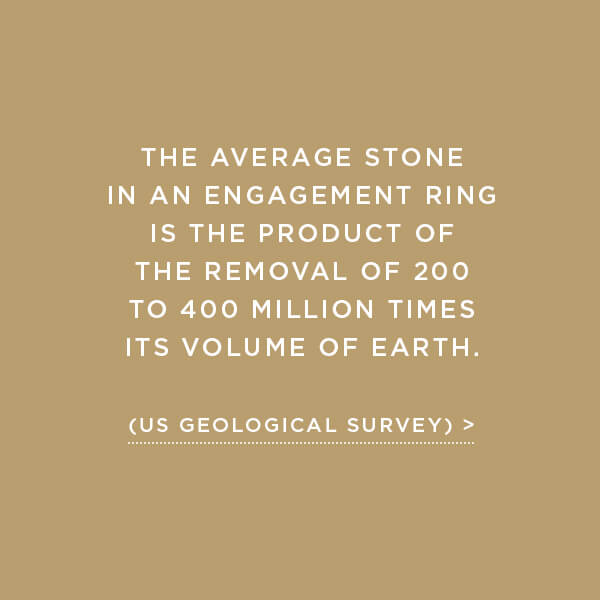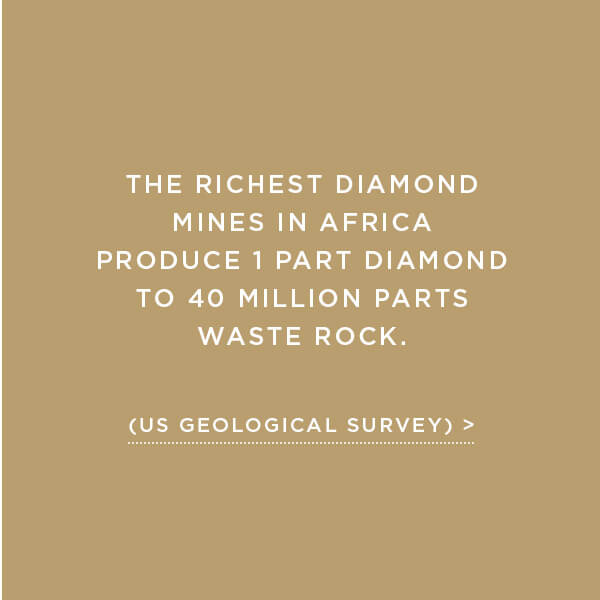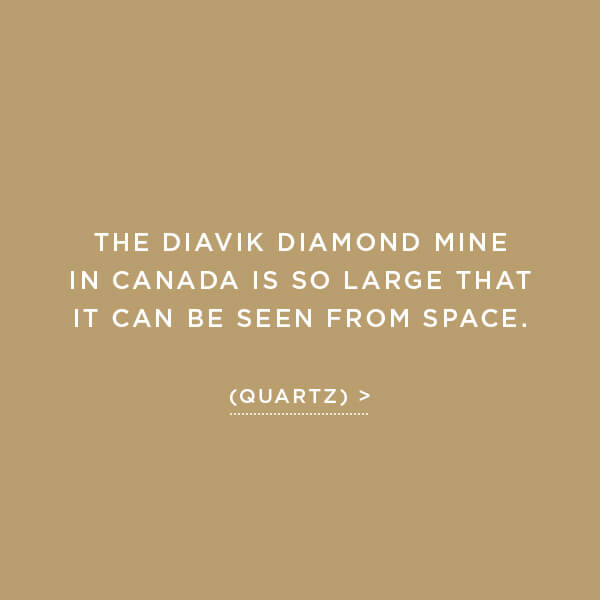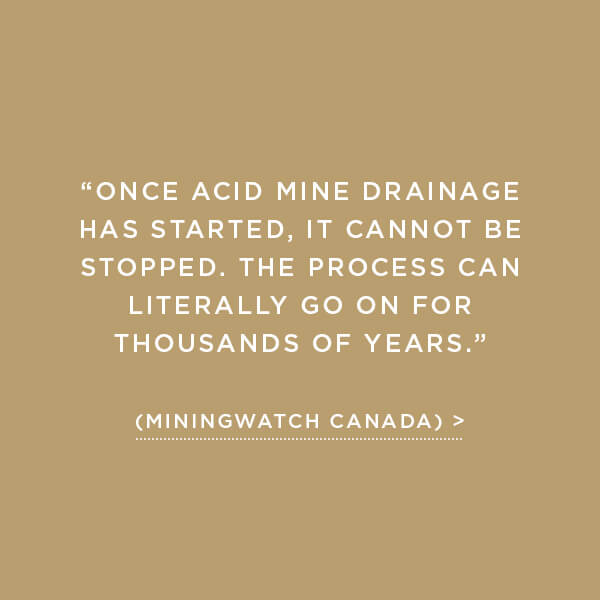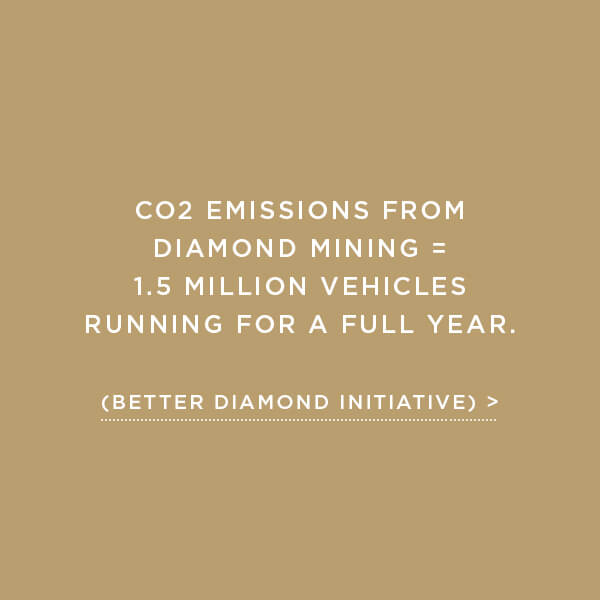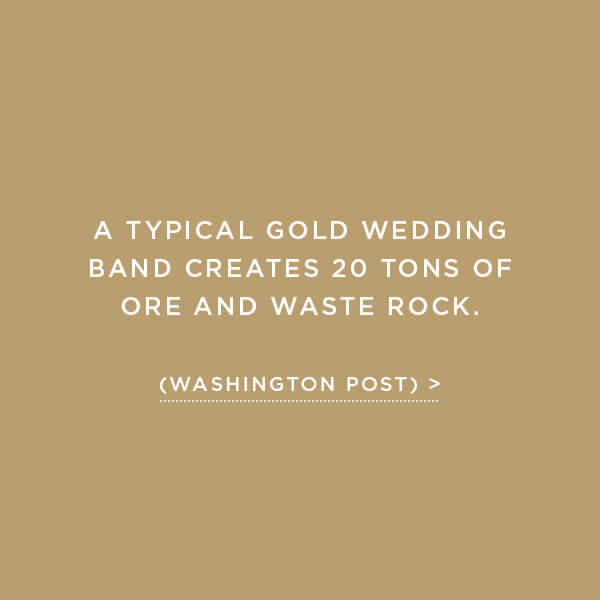Mined Diamonds are Forever Destructive
September 13th, 2017 / Alese Oldenburg
What’s the true cost of a corporate-mined diamond?
It’s an uncomfortable question. No one wants to carry the guilt of the landscapes, habitats, and wildlife whose destruction is not tabulated on your tennis bracelet’s receipt. The easiest coping mechanism is to ignore the question – just shrug it off because “it’s not my problem.” Or, shrug it off because “there’s nothing I can do about it.”
Fortunately, unlike our parents’ generation, our generation has a choice. We can choose the source of our diamonds. We can ask the tough questions about corporate-mined diamonds because we have options. We don’t need to shrug-off the true cost of corporate-mined diamonds because we can choose to purchase diamonds extracted from the Earth or forged in more ethical and industrious ways.
Forget the guilt for a moment. What’s the true cost of a corporate-mined diamond? If you do a little digging, there’s a gold mine of information available. Or ask an astronaut, because they can literally see open-pit corporate mines from space.
Here’s a primer to get you started.

The most visible impact of mining is the sheer amount of rock and dirt that is moved to reach the diamonds deep in the ground.
Miners don’t mine on lifeless wastelands.
They mine where they think the diamonds are. Whatever people, animals, and ecosystems lived there before don’t live there after the miners get started.
Mined-diamond jewelers often claim that diamonds from Canada are less irresponsible than those from Africa because they don’t involve child soldiers and exploitative labor practices. That would be true if not for two inconvenient facts.
Diamond traders ship stones all over the world in a competitive market. Whatever dollars you spend on a Canadian diamond prop-up the market for African diamonds. Canadian stones with equal size, cut, color and clarity are being sold for a premium price just because they’re from Canada.
Miners don’t mine on lifeless wastelands.Every day, Canadian mines produce one million tons of waste rock and 950,000 tons of tailings, which are finely ground rocks and minerals from processing extracted materials like diamonds.

All of the waste rock and tailings have to be stored somewhere.
Storage is a highly generous term for the process of stacking massive piles of waste rock on land and dumping massive quantities of tailings and processing chemicals into “tailings ponds.”
These byproducts of mining create chemical reactions that produce acidic water which dissolves lead, copper and zinc. It’s bad news for the whole food chain when this toxic concoction leaches into the groundwater and contaminates the living things that depend on it.
In northern Canada, this waste is stored in frozen dams. It sounds like a good idea, but unfortunately Arctic latitudes are warming at three times the rate of the rest of the world, melting ice and the permafrost that keeps such waste contained. As the frozen ground thaws more each summer, acid rock drainage could result in a massive leaching of heavy metals into the soil and water sources. A National Round Table on the Environment and the Economy report concisely summarized the impacts of mining excrement as “environmentally and socially disastrous, causing irreversible degradation of sensitive habitat and human health impacts.”

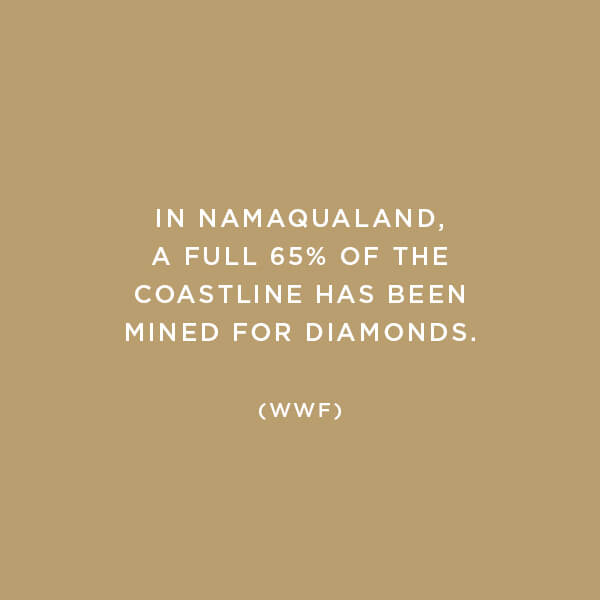
Back in northern Canada, herds of caribou and muskoxen roam through the regions where diamond mine waste is stored. Native people fear that the animals will eat vegetation that grows near tailings ponds—which could introduce toxic heavy metals into the food chain.

Habitats on land aren’t the only ones in danger.


Moving these massive quantities of earth
takes an enormous amount of energy.
In 2012, the heat-trapping CO2 emissions from diamond mining were equivalent to about 1.5 million cars on the road. Americans use more electricity per household than any other country on Earth, and diamond mining uses enough electricity to power 1 million U.S. households. The sad irony is that these emissions accelerate the melting of Canada’s frozen waste deposits.

because mining for gold is also destructive. Nearly 75% of active gold mines and exploration sites occupy regions defined as “high conservation value.” These sites are often in low-income countries with weak or non-existent environmental regulations.

Once a mine is exhausted or abandoned, the devastation remains.

Diamonds are traditionally given as a gift of love. They last forever. Unfortunately, the destruction from their extraction also last forever.
Ivory is beautiful, but we’ve decided as a global community of nations that ivory is not worth the elephants who must die to harvest it. Diamonds are beautiful, but are they worth the ecosystems that must die to extract them? Governments aren’t doing much about it. You can do something about it.
We’re here to help.
http://www.miningfacts.org/Environment/How-are-waste-materials-managed-at-mine-sites/
http://www.miningfacts.org/Environment/What-is-acid-rock-drainage/
http://e360.yale.edu/features/the-pollution-fallout-from-zimbabwes-blood-diamonds
https://www.worldwildlife.org/ecoregions/at1322
http://www.deepseaminingoutofourdepth.org/
https://betterdiamondinitiative.org/environmental-cost-of-mined-diamonds-is-alarming/
http://nodirtygold.earthworksaction.org/impacts/natural-areas#.WbBretMrLUI
https://miningwatch.ca/sites/default/files/Brief-for-Philippines.pdf
https://www.thenational.ae/world/gang-wars-erupt-over-abandoned-mines-in-south-africa-1.35928


